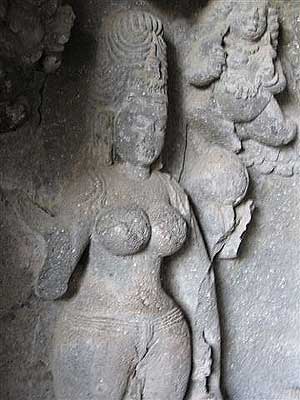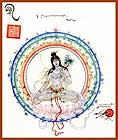|
|
|
|
|
|
|

(Elora's cave, India ra's cave, India). |
Tara
Amongst all Buddhist deities, the most beloved is Tara. She is said to have been born from a lotus that grew
in Avalokiteshvara' tears of compassion. She is known as the Mother of All Buddhas: the Perfection of Wisdom (the Ultimate True Nature, Emptiness, the immutable source and ground of everything).
As sentient beings we ourselves possess Buddha Nature, the exact qualities of all the Buddhas. As Buddhists, our path is to discover and nurture those qualities within us. While we must make this journey alone and through our own efforts, the Buddhas,
in the forms of the gurus and deities, can help us
on the path. Gurus give us instructions, blessings
and the direct experience of our own Buddha nature. Deities are symbolic representations of the ultimate nature of reality. Through deity visualization practice we are able to connect with that state and gradually transform ourselves into Buddhas.
|
|
While all Buddhas are fundamentally the same and are beyond duality or individualism, they differ in terms of the ways they can benefit us. These differences are due to their individual aspirations while
still on the path. As a Bodhisattva, Tara defied tradition by pledging to obtain omniscience in her female form. At that time, her aspiration was to achieve enlightenment specifically in order to protect all beings from distress and fear. Having subsequently attained Buddhahood, Tara is now able to completely fulfil her aspirations. Hence, by supplicating Tara, we can overcome dangers, fears, anxieties and difficult situations. And through the Tantric practice of visualizing ourselves as Tara, we can cultivate the compassion aspects of our Buddha nature.
|
|
Below is an excerpt from a teaching on Tara given by
Khenpo Tsultrim Gyamtso Rinpoche
|
|
Student:
Rinpoche, you said that bodhisattvas and bodhisattvis undertake hardships for the sake of others, and also this happens in stages, but I wonder if you could say how to do that if you are a beginning bodhisattva or bodhisattvi and you are suffering yourself?
KHENPO RINPOCHE:
The Path begins by giving rise to the bodhicitta, the resolve to obtain buddhahood in order to benefit others. In doing so one produces a feeling of great compassion for others, and it this great compassion which is the actual bodhicitta. So when you've given rise to that great compassion then you have given rise to bodhicitta, you have generated it. Then you travel through the Path of Accumulation, the Path of Application, the Path of Vision and the Path of Meditation and finally come upon the Path of Perfect Perfection.
On achieving the Paths of Vision and Meditation, from the 1st bodhisattva level up to the tenth, you are what is referred to as a noble being or a realized being, either male or female. There you are able to perform the benefit of others in a very vast way, tirelessly, and free of difficulty for oneself, effortlessly. The noble beings on these levels such as Chenrezig and Arya Tara are able to perform the benefit of others by sending out many magical emanation forms.
If we look at Tara she started out as an ordinary girl. She lived in a previous kalpa where she was born as the daughter of a king, so she was the princess in her kingdom. She meditated upon loving kindness and compassion, developed the bodhicitta and practiced diligently going through inconceivable training. Finally she developed an inconceivable degree of love and compassion for others which carried her through the different levels of direct realization such that she was able to emanate many magical emanation forms which perform the benefit of others. She accomplished an incredible feat, and now she works for the benefit of others as a yidam deity.
And she is able to protect one from fear. There are 8 types of fear that she can protect us from. In a more expanded explanation, there are 16 types of fear she can protect us from. The description of those is found in her life story.
Alexandra does a dance where she portrays the Noble Tara in the dance.
There is not time to perform the dance that illustrates the whole biography of Tara and the different kinds of fear that she us protects from, but there is time to do a brief portrayal of Tara's activity.
Alexandra dances and sings.
|
|
|
|
|
|
|
|
|
|
|
|

